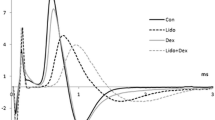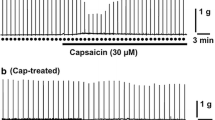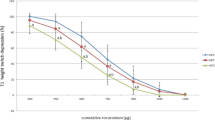Abstract
Although the intravenous general anesthetic propofol (2,6-diisopropylphenol) has an ability to inhibit nerve conduction, this has not been fully examined. Various agents inhibit compound action potentials (CAPs) in a manner dependent on their chemical structures. To determine propofol’s chemical structure that is important in nerve conduction inhibition, we examined the effects of propofol and its related compounds on fast-conducting CAPs recorded from the frog sciatic nerve by using the air-gap method. Propofol concentration-dependently reduced the peak amplitude of the CAP with a half-maximal inhibitory concentration (IC50) value of 0.14 mM. A similar inhibition was produced by other phenols, 4-sec-butylphenol and 4-amylphenol (IC50 values: 0.33 and 0.20 mM, respectively). IC50 values for these and more phenols (4-isopropylphenol, 4-tert-butylphenol, and 4-ter-amylphenol; data published previously) were correlated with the logarithm of their octanol-water partition coefficients. A phenol having ketone group (raspberry ketone) and alcohols (3-phenyl-1-propanol and 2-phenylethylalcohol) inhibited CAPs less effectively than the above-mentioned phenols. The local anesthetic (LA) benzocaine reduced CAP peak amplitudes with an IC50 of 0.80 mM, a value larger than that of propofol. When compared with other LAs, propofol activity was close to those of ropivacaine, levobupivacaine, and pramoxine, while benzocaine activity was similar to those of cocaine and lidocaine. It is concluded that propofol inhibits nerve conduction, possibly owing to isopropyl and hydroxyl groups bound to the benzene ring of propofol and to its lipophilicity; propofol’s efficacy is comparable to those of some LAs. These results could serve to develop propofol-related agents exhibiting analgesia when applied topically.




Similar content being viewed by others
Abbreviations
- CAP:
-
Compound action potential
- IC50 :
-
Half-maximal inhibitory concentration
- Kow :
-
Octanol-water partition coefficient
- LA:
-
Local anesthetic
- nH :
-
Hill coefficient
- TRPA1:
-
Transient receptor potential ankyrin-1
- TRPV1:
-
Transient receptor potential vanillioid-1
References
Catterall WA, Mackie K (2011) Local anesthetics. In: Brunton LL, Chabner BA, Knollmann BC (eds) Goodman & Gilman’s the pharmacological basis of therapeutics, 12th edn. McGraw-Hill, Medical Publishing Division, New York, USA, pp 565–582
ChemIDplus (2017) Bethesda, MD: National Library of medicine (US); [update daily; accessed 2017 October 18]. Available at: https://chem.nlm.nih.gov/chemidplus/
Cheng SS, Yeh J, Flood P (2008) Anesthesia matters: patients anesthetized with propofol have less postoperative pain than those anesthetized with isoflurane. Anesth Analg 106:264–269
Dalkilic N, Tuncer S, Bariskaner H, Kiziltan E (2009) The effect of tramadol on the rat sciatic nerve conduction: a numerical analysis and conduction velocity distribution study. Yakugaku Zasshi 129:485–493
Doze VA, Westphal LM, White PF (1986) Comparison of propofol with methohexital for outpatient anesthesia. Anesth Analg 65:1189–1195
Fields HL (1987) Pain, McGraw-Hill. USA, New York
Fischer MJM, Leffler A, Niedermirtl F, Kistner K, Eberhardt M, Reeh PW, Nau C (2010) The general anesthetic propofol excites nociceptors by activating TRPV1 and TRPA1 rather than GABAA receptors. J Biol Chem 285:34781–34792
Franks NP, Lieb WR (1994) Molecular and cellular mechanisms of general anaesthesia. Nature 367:607–614
Frenkel C, Urban BW (1991) Human brain sodium channels as one of the molecular target sites for the new intravenous anaesthetic propofol (2,6-diisopropylphenol). Eur J Pharmacol 208:75–79
Guedes CM, Pinto AB, Moreira RFA, De Maria CAB (2004) Study of the aroma compounds of rose apple (Syzygium jambos Alston) fruit from Brazil. Eur Food Res Technol 219:460–464
Guénette SA, Giroux M-C, Vachon P (2013) Pain perception and anaesthesia in research frogs. Exp Anim 62:87–92
Güven M, Mert T, Günay I (2005) Effects of tramadol on nerve action potentials in rat: comparisons with benzocaine and lidocaine. Int J Neurosci 115:339–349
Hales TG, Lambert JJ (1991) The actions of propofol on inhibitory amino acid receptors of bovine adrenomedullary chromaffin cells and rodent central neurones. Br J Pharmacol 104:619–628
Hanrahan SJ, Greger B, Parker RA, Ogura T, Obara S, Egan TD, House PA (2013) The effects of propofol on local field potential spectra, action potential firing rate, and their temporal relationship in humans and felines. Front Hum Neurosci 7:136
Hirao R, Fujita T, Sakai A, Kumamoto E (2018) Compound action potential inhibition produced by various antidepressants in the frog sciatic nerve. Eur J Pharmacol 819:122–128
Honkanen E, Pyysalo T, Hirvi T (1980) The aroma of finnish wild raspberries, Rubus idaeus, L. Z Lebensm Unters Forsch 171:180–182
James R, Glen JB (1980) Synthesis, biological evaluation, and preliminary structure-activity considerations of a series of alkylphenols as intravenous anesthetic agents. J Med Chem 23:1350–1357
Jones PJ, Wang Y, Smith MD, Hargus NJ, Eidam HS, White HS, Kapur J, Brown ML, Patel MK (2007) Hydroxyamide analogs of propofol exhibit state-dependent block of sodium channels in hippocampal neurons: implications for anticonvulsant activity. J Pharmacol Exp Ther 320:828–836
Katsuki R, Fujita T, Koga A, Liu T, Nakatsuka T, Nakashima M, Kumamoto E (2006) Tramadol, but not its major metabolite (mono-O-demethyl tramadol) depresses compound action potentials in frog sciatic nerves. Br J Pharmacol 149:319–327
Kawasaki H, Mizuta K, Fujita T, Kumamoto E (2013) Inhibition by menthol and its related chemicals of compound action potentials in frog sciatic nerves. Life Sci 92:359–367
Kobayashi J, Ohta M, Terada Y (1993) C fiber generates a slow Na+ spike in the frog sciatic nerve. Neurosci Lett 162:93–96
Kobayashi M, Oi Y (2017) Actions of propofol on neurons in the cerebral cortex. J Nippon Med Sch 84:165–169
Kosugi T, Mizuta K, Fujita T, Nakashima M, Kumamoto E (2010) High concentrations of dexmedetomidine inhibit compound action potentials in frog sciatic nerves without α2 adrenoceptor activation. Br J Pharmacol 160:1662–1676
Kumamoto E, Mizuta K, Fujita T (2012) Peripheral nervous system in the frog as a tool to examine the regulation of the transmission of neuronal information. In: Murray JL (ed) Frogs: biology, ecology and uses. Nova Science Publishers, Inc., New York, pp 89–106
Kumamoto E, Murata Y (1996) Enhancement by lanthanide of general anesthetic-induced GABAA-receptor current in rat septal cholinergic neurons in culture. J Neurophysiol 75:2294–2299
Lee H-S (2016) Recent advances in topical anesthesia. J Dent Anesth Pain Med 16:237–244
Magori N, Fujita T, Kumamoto E (2018) Hinokitiol inhibits compound action potentials in the frog sciatic nerve. Eur J Pharmacol 819:254–260
Martella G, De Persis C, Bonsi P, Natoli S, Cuomo D, Bernardi G, Calabresi P, Pisani A (2005) Inhibition of persistent sodium current fraction and voltage-gated L-type calcium current by propofol in cortical neurons: implications for its antiepileptic activity. Epilepsia 46:624–635
Mizuta K, Fujita T, Nakatsuka T, Kumamoto E (2008) Inhibitory effects of opioids on compound action potentials in frog sciatic nerves and their chemical structures. Life Sci 83:198–207
Mizuta K, Fujita T, Yamagata H, Kumamoto E (2017) Bisphenol A inhibits compound action potentials in the frog sciatic nerve in a manner independent of estrogen receptors. Biochem Biophys Rep 10:145–151
Nadeson R, Goodchild CS (1997) Antinociceptive properties of propofol: involvement of spinal cord γ-aminobutyric acidA receptors. J Pharmacol Exp Ther 283:1181–1186
Ohtsubo S, Fujita T, Matsushita A, Kumamoto E (2015) Inhibition of the compound action potentials of frog sciatic nerves by aroma oil compounds having various chemical structures. Pharmcol Res Perspect 3:e00127
Orser BA, Bertlik M, Wang L-Y, MacDonald JF (1995) Inhibition by propofol (2,6 di-isopropylphenol) of the N-methyl-D-aspartate subtype of glutamate receptor in cultured hippocampal neurones. Br J Pharmacol 116:1761–1768
Ratnakumari L, Hemmings HC Jr (1997) Effects of propofol on sodium channel-dependent sodium influx and glutamate release in rat cerebrocortical synaptosomes. Anesthesiology 86:428–439
Rehberg B, Duch DS (1999) Suppression of central nervous system sodium channels by propofol. Anesthesiology 91:512–520
Shafer A, Doze VA, Shafer SL, White PF (1988) Pharmacokinetics and pharmacodynamics of propofol infusions during general anesthesia. Anesthesiology 69:348–356
Shi Q-Q, Sun X, Fang H (2014) A mechanism study on propofol’s action on middle latency auditory evoked potential by neurons in ventral partition of medial geniculate body in rats. Eur Rev Med Pharmacol Sci 18:1859–1868
Shyr M-H, Tsai TH, Yang C-H, Chen H-M, Ng H-F, Tan PPC (1997) Propofol anesthesia increases dopamine and serotonin activities at the somatosensory cortex in rats: a microdialysis study. Anesth Analg 84:1344–1348
Song C-Y, Xi H-J, Yang L, Qu L-H, Yue Z-Y, Zhou J, Cui X-G, Gao W, Wang N, Pan Z-W, Li W-Z (2011) Propofol inhibited the delayed rectifier potassium current (Ik) via activation of protein kinase C epsilon in rat parietal cortical neurons. Eur J Pharmacol 653:16–20
Sun Y-Y, Li K-C, Chen J (2005) Evidence for peripherally antinociceptive action of propofol in rats: behavioral and spinal neuronal responses to subcutaneous bee venom. Brain Res 1043:231–235
Suzuki R, Fujita T, Mizuta K, Kumamoto E (2018) Inhibition by non-steroidal anti-inflammatory drugs of compound action potentials in frog sciatic nerve fibers. Biomed Pharmacother 103:326–335
Takechi K, Carstens MI, Klein AH, Carstens E (2013) The antinociceptive and antihyperalgesic effects of topical propofol on dorsal horn neurons in the rat. Anesth Analg 116:932–938
Thygesen MM, Rasmussen MM, Madsen JG, Pedersen M, Lauridsen H (2017) Propofol (2, 6-diisopropylphenol) is an applicable immersion anesthetic in the axolotl with potential uses in hemodynamic and neurophysiological experiments. Regeneration 4:124–131
Tokuno HA, Bradberry CW, Everill B, Agulian SK, Wilkes S, Baldwin RM, Tamagnan GD, Kocsis JD (2004) Local anesthetic effects of cocaethylene and isopropylcocaine on rat peripheral nerves. Brain Re 996:159–167
Tomohiro D, Mizuta K, Fujita T, Nishikubo Y, Kumamoto E (2013) Inhibition by capsaicin and its related vanilloids of compound action potentials in frog sciatic nerves. Life Sci 92:368–378
Tsutsumi S, Tomioka A, Sudo M, Nakamura A, Shirakura K, Takagishi K, Kohama K (2001) Propofol activates vanilloid receptor channels expressed in human embryonic kidney 293 cells. Neurosci Lett 312:45–49
Uemura Y, Fujita T, Ohtsubo S, Hirakawa N, Sakaguchi Y, Kumamoto E (2014) Effects of various antiepileptics used to alleviate neuropathic pain on compound action potential in frog sciatic nerves: comparison with those of local anesthetics. Biomed Res Int 2014:540238
Vanable JW (1985) Benzocaine: an excellent amphibian anesthetic. Axolotl Newsletter 14:19–21
Vasileiou I, Xanthos T, Koudouna E, Perrea D, Klonaris C, Katsargyris A, Papadimitriou L (2009) Propofol: a review of its non-anaesthetic effects. Eur J Pharmacol 605:1–8
Veintemilla F, Elinder F, Århem P (1992) Mechanisms of propofol action on ion currents in the myelinated axon of Xenopus laevis. Eur J Pharmacol 218:59–68
Wakita M, Kotani N, Akaike N (2016) Effects of propofol on glycinergic neurotransmission in a single spinal nerve synapse preparation. Brain Res 1631:147–156
Yamakura T, Bertaccini E, Trudell JR, Harris RA (2001) Anesthetics and ion channels: molecular models and sites of action. Annu Rev Pharmacol Toxicol 41:23–51
Yamakura T, Sakimura K, Shimoji K, Mishina M (1995) Effects of propofol on various AMPA-, kainate- and NMDA-selective glutamate receptor channels expressed in Xenopus oocytes. Neurosci Lett 188:187–190
Yilmaz-Rastoder E, Gold MS, Hough KA, Gebhart GF, Williams BA (2012) Effect of adjuvant drugs on the action of local anesthetics in isolated rat sciatic nerves. Reg Anesth Pain Med 37:403–409
Funding
This research was partly supported by JSPS KAKENHI, grant number 15 K08673.
Author information
Authors and Affiliations
Corresponding author
Ethics declarations
This study was approved by the Animal Care and Use Committee of Saga University, Saga, Japan.
Conflict of interest
The authors declare that they have no conflicts of interest.
Additional information
Publisher’s Note
Springer Nature remains neutral with regard to jurisdictional claims in published maps and institutional affiliations.
Rights and permissions
About this article
Cite this article
Magori, N., Fujita, T., Mizuta, K. et al. Inhibition by general anesthetic propofol of compound action potentials in the frog sciatic nerve and its chemical structure. Naunyn-Schmiedeberg's Arch Pharmacol 392, 359–369 (2019). https://doi.org/10.1007/s00210-018-01596-w
Received:
Accepted:
Published:
Issue Date:
DOI: https://doi.org/10.1007/s00210-018-01596-w




